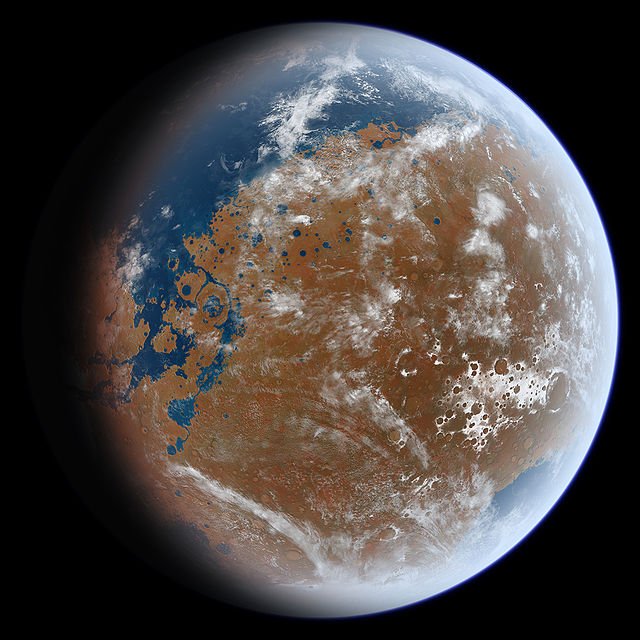
Image Credit: NASA/GSFC
Ricercatori della NASA hanno realizzato una serie di mappe uniche della distribuzione atmosferica dell’acqua marziana da cui emergono nuovi indizi su quello che doveva essere l’oceano primitivo del pianeta rosso. I risultati suggeriscono che circa 4,5 miliardi di anni fa Marte aveva abbastanza acqua tale da coprire almeno il 20% della sua superficie e che poi è andata persa nello spazio nel corso del tempo geologico. Questo lavoro permette di comprendere meglio la storia evolutiva dell’acqua su Marte e fornisce uno strumento di indagine utile per identificare potenziali depositi d’acqua sotterranei.
Una serie di mappe della distribuzione atmosferica dell’acqua marziana, realizzate da un gruppo di ricercatori della NASA guidati da Geronimo Villanueva grazie ad alcuni tra i maggiori telescopi terrestri, hanno permesso di determinare che su Marte esisteva un oceano primitivo caratterizzato da un volume d’acqua di almeno 20 milioni di chilometri cubi, superiore rispetto a quello dell’Oceano Artico qui sulla Terra, e che poi nel corso del tempo l’87% è finito nello spazio. Da giovane, il pianeta avrebbe avuto abbastanza acqua da coprire l’intera superficie formando uno strato liquido profondo circa 137 metri. Non solo, ma l’acqua avrebbe inoltre formato un oceano occupando quasi metà dell’emisfero nord e raggiungendo in alcune regioni delle profondità maggiori di qualche chilometro. «Il nostro studio fornisce una stima solida di quello che era il contenuto d’acqua su Marte», spiega Villanova, autore principale dell’articolo pubblicato su Science. «Questo lavoro permette di comprendere meglio la storia evolutiva dell’acqua sul pianeta rosso».
Fonte/Leggi tutto → Media.INAF.it
A primitive ocean on Mars held more water than Earth’s Arctic Ocean, according to NASA scientists who, using ground-based observatories, measured water signatures in the Red Planet’s atmosphere. Scientists have been searching for answers to why this vast water supply left the surface. Details of the observations and computations appear in Thursday’s edition of Science magazine.
“Our study provides a solid estimate of how much water Mars once had, by determining how much water was lost to space,” said Geronimo Villanueva, a scientist at NASA’s Goddard Space Flight Center in Greenbelt, Maryland, and lead author of the new paper. “With this work, we can better understand the history of water on Mars.” Perhaps about 4.3 billion years ago, Mars would have had enough water to cover its entire surface in a liquid layer about 450 feet (137 meters) deep. More likely, the water would have formed an ocean occupying almost half of Mars’ northern hemisphere, in some regions reaching depths greater than a mile (1.6 kilometers). The new estimate is based on detailed observations made at the European Southern Observatory’s Very Large Telescope in Chile, and the W.M. Keck Observatory and NASA Infrared Telescope Facility in Hawaii. With these powerful instruments, the researchers distinguished the chemical signatures of two slightly different forms of water in Mars’ atmosphere. One is the familiar H2O. The other is HDO, a naturally occurring variation in which one hydrogen is replaced by a heavier form, called deuterium. By comparing the ratio of HDO to H2O in water on Mars today and comparing it with the ratio in water trapped in a Mars meteorite dating from about 4.5 billion years ago, scientists can measure the subsequent atmospheric changes and determine how much water has escaped into space.
Source/Continue reading → NASA.gov





















